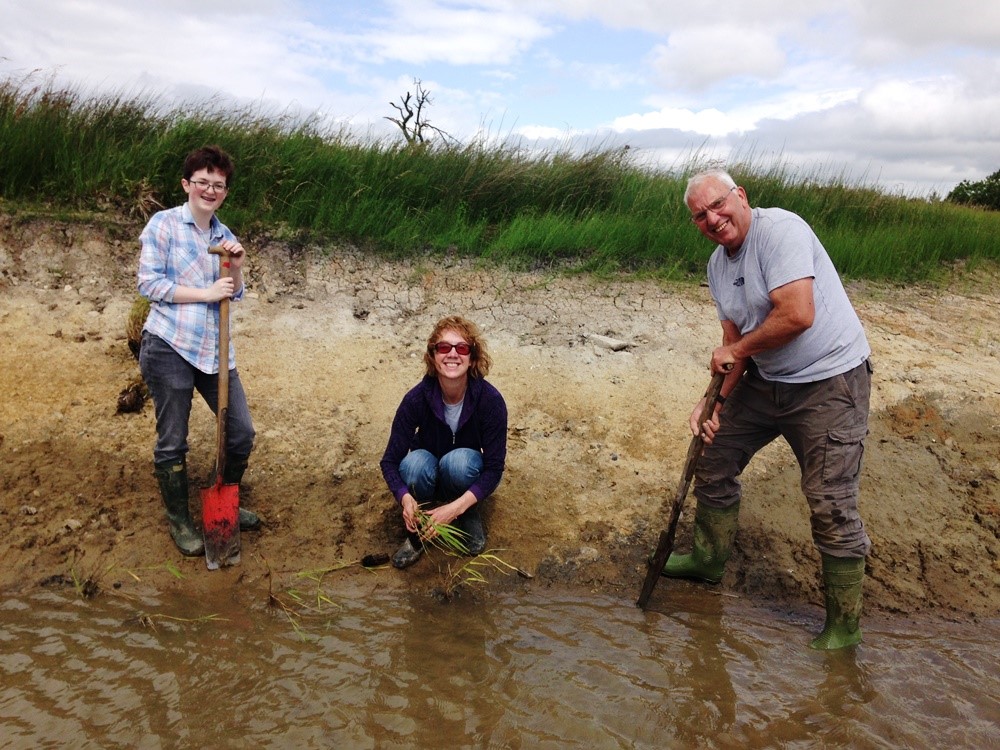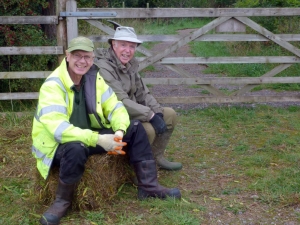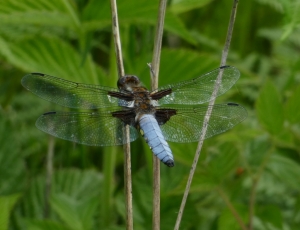Blog Archive (27) Posts Made in August 2011
First Bonfire and Last CES of the year
Tuesday, August 30th 2011
A busy day with the volunteers clearing the remaining brash from the horse logging on the open day. Two bonfires saw the mess quickly disappear before we moved onto clearing the area of self-seeded birch.

In the middle of all the Birch we discovered some small Hazel, Oak, Hawthorn and Aspen that had been almost completely smothered by the birch.
 .
.
Meanwhile the ringers have been busy since 5:30am with the final CES session of the year. A record 319 birds were processed keeping everyone very busy throughout the day. A quick assessment of the figures now that the final session is over shows that 2707 birds were caught on CES this year - the highest number ever in the 19 years the scheme has run at Foxglove. 2479 were trapped in 2006 which was the previous record. 2394 hours have been spent ringing over the years which equates to 100 days and nights non - stop! 3101 new birds have already been ringed in Foxglove this year which is well on the way to an all time record. As far as individual species are concerned there have been 46, and totals for these include 159 Bullfinch, 291 Lesser Redpoll, 442 Chaffinch, 209 Willow Warblers, 109 Chiffchaff, 56 Wren and 98 Robin. Thanks go to the scribe, ringers, staff and volunteers for their invaluable help in producing this outstanding data set - and for the gardening, net ride maintenance and production of endless cups of tea and sticky buns. It is a remarkable achievement.

Species List
Monday, August 29th 2011
Since the early years of Foxglove Covert, a list of the species has been kept. The latest update has been completed and the number of species now recorded stands at 2084. New species include fungi, a flower, a moth and of course the spiders. However the most ugliest? slimiest? beautiful? species to be noted is this Egg Shell Slimemould Leocarpus fragilis!

What a Morning!
Sunday, August 28th 2011
As usual the weather was very important - would it rain, would it stay dry for our Eco club meeting? Plans B and C were ready. People arrived all prepared for wet weather, wellies essential, but we were so lucky as it stayed dry and sunny for our walk.
We were looking at how different habitats on the reserve were managed. Our first habitat involved a walk through an uncleared part of the heath, so prickles and thistles were well and truly felt. A stop at the heath that the volunteers had cleared showed the differences.
Thistles bigger than Elizabeth, were home to several 7 Spot Ladybirds which we were counting. Crossing Risedale Beck we almost bumped into this huge Burdock and of course it had to be felt and was claimed to be prickly and tickly!

Up the steps, right turn, taking the path through the woodland to the new plantation, where funny shaped trees, pine needles, bones, fungi and Foxglove leaves, sunshine and darkness were all looked at and discussed. Continued walking brought us to the Blubell bank recently strimmed and raked. Fly Agaric was seen and close by a Stinkhorn fungus, that had been chewed before it could 'stink' with its fantastic aroma.
The Gorse bushes on the left as we topped the hill from Risedale Beck yielded several ladybirds, some right inside the very spikey prickles. One very kindly came out and we asked it to smile for the camera, as you can see in this photo!

Whilst looking for the ladybirds and finding them and spiders, this bug was spotted and photgraphed by Alicia. Initially it was thought to be a shield bug. Investigation by Catherine shows it to be the instar of Zicron caerulea, the Blue Bug. This is a new species for our Species List. Absolutely great!!

As we headed back to the Centre two Brimstone Butterflies were seen flying around which thrilled everybody.
Having had a smiling ladybird we decided we had to have a smiling Eco Club for the blog!

Thank you to everyone who came and helped to make the walk so interesting, with all the different plants and animals spotted, good questions and good answers all round too.
News from Cape Wrath and a soggy Foxglove
Saturday, August 27th 2011
Modern technology has resulted in news from the ringing team in Cape Wrath. They caught and processed 204 Storm Petrels last night, including a Norwegian control and two other UK controls. The photo below shows a Twite that was also ringed.

Meanwhile the damp morning turned into a very wet afternoon but this did not stop visitors coming to walk around and enjoy a rather soggy Foxglove Covert. You can see by the pine needles the size of this Common Toad who was also enjoying a walk through the woodland. He will not long have left the pond where he spent the first weeks of his life. His food will be tiny insects and other invertebrates. Over winter he will hibernate.

Although most invertebrates were well hidden away to avoid the rain, this harvestman was staying dry on a tree trunk.

Spiders, Bluebells and Hazelnuts!
Thursday, August 25th 2011
There are spiders everywhere at this time of year. This Garden Cross Spider was busy alongside the beck.

As the summer draws to an end, a start can be made on the Autumn conservation tasks. The Bluebell bank up in the woodland is strimmed to prevent the Bracken and Brambles from taking over and smothering the Spring flowers.

The ferns remain on this beautiful glade.

Elsewhere, the first signs of Autumn are starting to appear. The squirrels are already eating the hazelnuts even though they are not yet fully ripe

Four Spot Orb Weaver
Wednesday, August 24th 2011
The thistles that were pulled yesterday were removed from the wetland. It took two trailer loads of squashed thistles!

Whilst loading tthem up, this striking spider was found. A similar one was seen yesterday by David and Adam in the same habitat. It is a female Four spot orb weaver (Araneus quadratus).

This one was busy spinning silk as Elizabeth photographed it!

Elizabeth also rescued this fresh Common Darter from a spider's web!

Ann stumbled across this amazing patch of fungus close to the Field Centre yesterday. Brian's photo is only of a small part of this spectacular mound containing hundreds of fruiting bodies.

After only three days of work, Adam has left us and is heading north with the bird ringing team to Cape Wrath! We wish the group all the best, a safe journey, good weather and plenty of Storm Petrels!
Thistles and Dragonflies
Tuesday, August 23rd 2011
Adam was introduced to the volunteers today and the task was the inevitable 'thistle pulling' on the wetland! Twelve people worked hard all day to remove the spiky invaders!
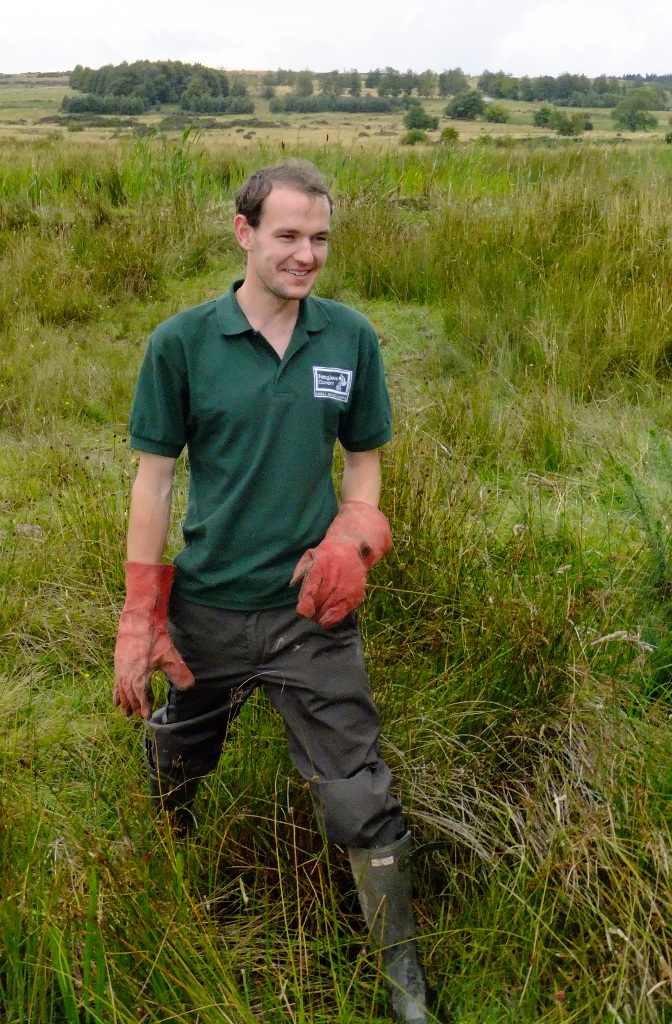
Everyone spread out across the entire habitat and managed to avoid wet feet.

The thistles were carried to a central point in sacks which involved hopping over Adam's dodgy makeshift floating bridge!

All around, dragonflies were emerging after their nymph stage and resting in the rushes to dry.
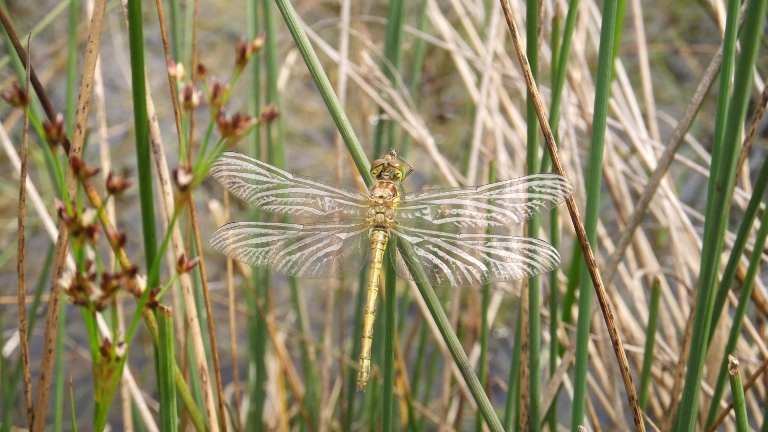
Here is the team at lunch time with almost all of the thistles.

Thank you everyone, another job is crossed off the (ever increasing) list!
Woodland treasures
Tuesday, August 23rd 2011
The woodland walk yielded many treasures today. Beautiful trees hidden away in a corner were looked at and another job was added to the winter list - clear some trees away to give more space and light to those left. Under the leaf of a Sycamore tree a yellow with black spots, ladybird larva was seen. We are trying to identify it. Pathways through the long grass led to areas of flattened grass where the deer had been resting.
This small orange-coloured fungus looks like deer's antlers - maybe we can identify this too!
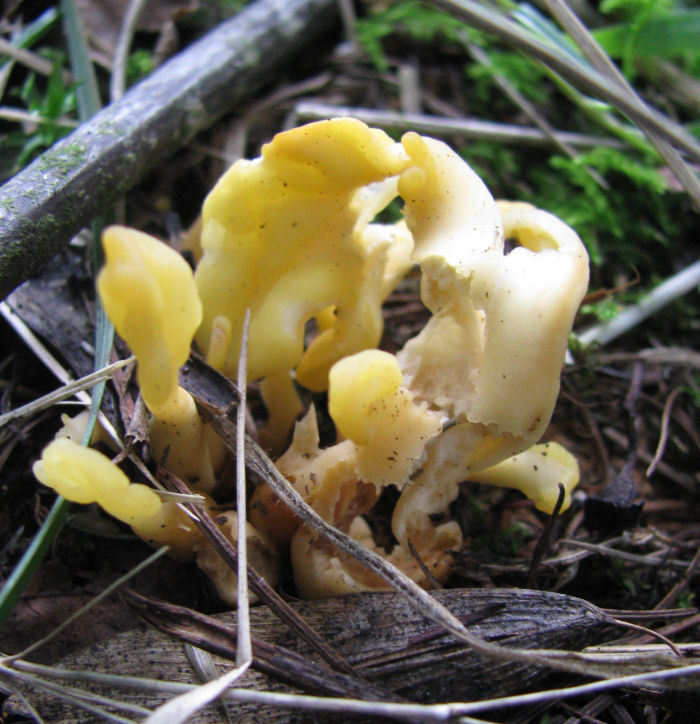
Another fungi or slimemould, showing itself, is this furry one. As it matures it turns brown.
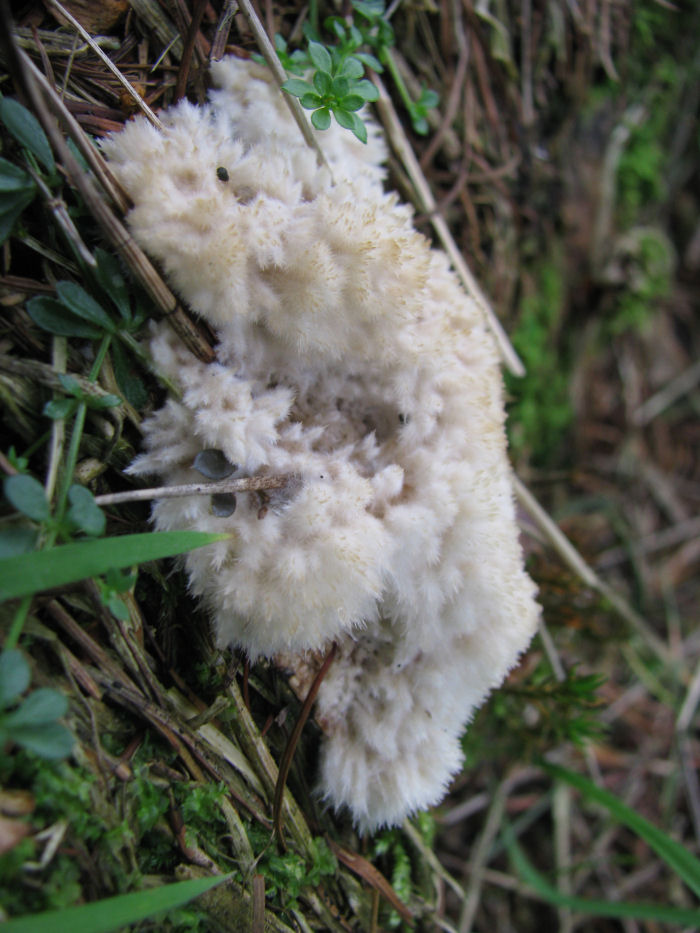
Dog Violets are spring flowers but this one has decided to put in an appearance now. You can see the honey guides on the petals.
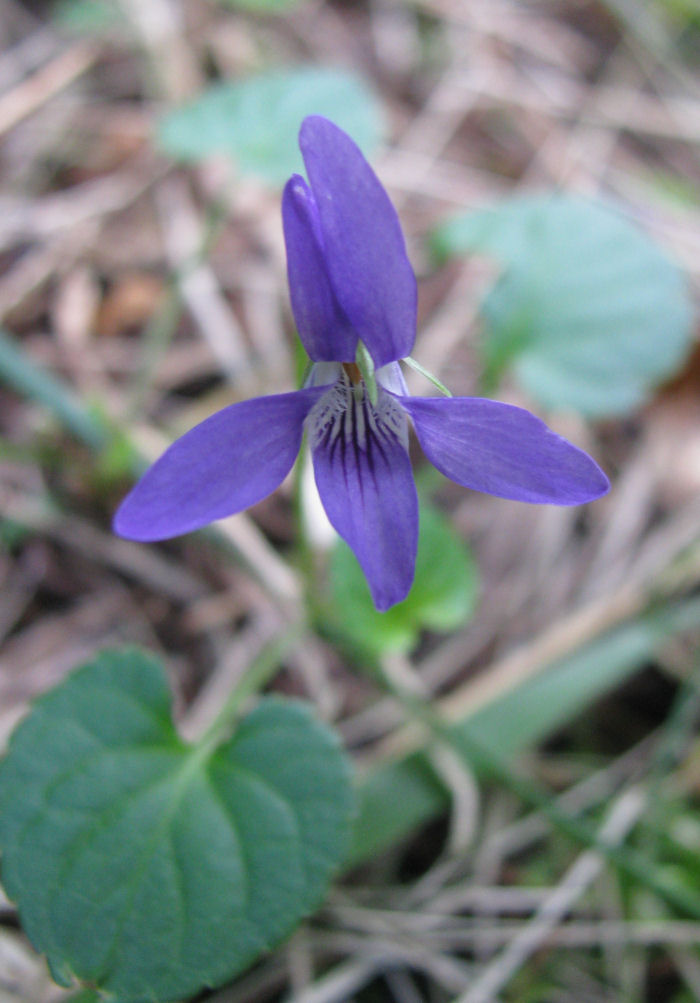
And finally a reminder that autumn is just round the corner. This Sycamore tree was showing its beautiful autumn colours.
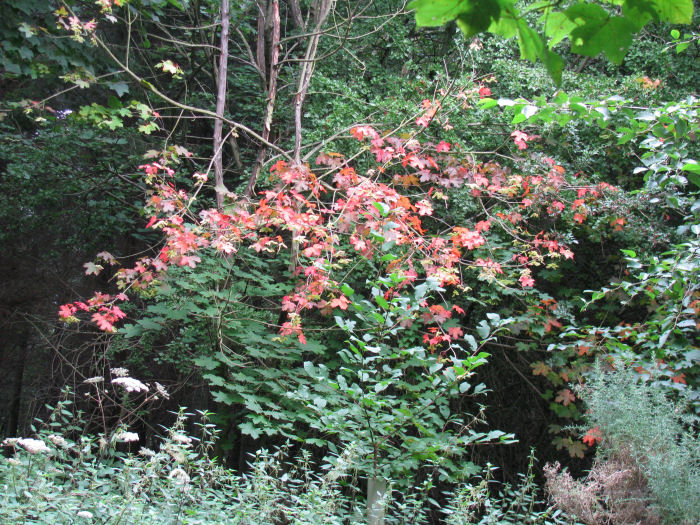
CES 11
Sunday, August 21st 2011
A beautiful sunrise over the lake was the backdrop to the nets being put up for CES day 11.

The Moon and Jupiter could be be seen in the clear sky.

Swaledale Ringing Group was joined by members of the Army and Royal Air Force Ornithological Societies for the day, and together they processed over 260 birds, including Nuthatch, 27 new Bullfinches, Redstart, almost the last of the Willow Warblers, Willow Tit, Lesser Redpoll, Blackcap and Goldcrest. There were several juvenile, angelic looking Blue Tits, who - although small -have a painful nip! One of the last birds brought back as the nets were taken down ten and half hours after they had been put up, was a Whitethroat.
At 265 birds caught this was the best result for CES day 11 in all of the 19 years the project has been running at Foxglove. It brought the number of new birds ringed on the site to 45637 of 76 species!
Sun and warmth meant that the insect life was abundant and the Butterfly Walk lead by Bob saw many butterflies including Comma, Small Heath, Red Admiral and the dancing Speckled Wood. Later in the afternoon a Brimstone was seen.
The regular sightings of 7 Spot Ladybirds continued today.

The Kidney Spot Ladybirds who have spent all of their lives so far, on the Ash trees are on the move. As they are meant to eat Scale insects, we are not sure what they are finding to eat in their new homes, the picnic tables and the side of the fuel store!

Nature Detectives
Saturday, August 20th 2011
A lovely warm and dry day saw 25 children ready to set off to be Nature Detectives. Sophie's group went one way, whilst Elizabeth's went the other. We were looking for prickly, tickly, smelly, sticky things and we all did well finding them! Thistles were prickly and the long grass was tickly. Many 7 Spot Ladybirds were seen. It was decided that this one was just a little tickly!
.jpg)
Another task was to make a palette of colours from the plants. Only tiny pieces were allowed to be picked. Here you can see some of the completed ones.


Saw-wort, another new species
Thursday, August 18th 2011
On 20th July Ann found what she thought to be, Saw-wort, (Serratula tinctoria) which was a new species for the reserve. It was on the heath and still in bud. We have watched it develop ever since, waiting for it to flower to confirm its identity. By this afternoon some flowers were fully opened, as can be seen in the photograph below.
.jpg)
The (very scientifically described) 'furry' bees were busy enjoying the nectar.

Although Hardheads (Common Knapweed, Black Knapweed) have featured on the blog recently it is here again for comparison. This flower is also favoured by many insects.

Plan B - Trail Blazing in the New Plantation!
Tuesday, August 16th 2011
The planned 'thistle pulling' was postponed today and instead of getting soaked in the rain on the wetland the volunteers made a bee line for the shelter of the newly acquired plantation! As you can see from the photo below, there is a massive amount of work to be done on this previously neglected area of conifer plantation.

Volunteers soon got 'stuck in' and cleared out Gorse and low branches from the conifers to allow more light into this habitat which has huge potential. Brian blazed a trail right accross from one side to the other!

There was plenty of cutting and dragging and by early afternoon everybody was exhausted!

This is an area that has been brashed and cleared. Before this work you couldn't even walk through the woodland.

In this area of Scots Pine there are plenty of Foxgloves trying to grow. After today they will have a lot more light and should flourish. Whilst working here, Bethany and Ann discovered two 'nests' of fungus! It seems that the pine needles have fallen from the trees and built up in a fork of branches and provided the ideal conditions for its growth.

It is really quite beautiful and a first glance at the fungus guide identifies it as Macrocystida cucumis. This will be confirmed!

Meet The Birds!
Tuesday, August 16th 2011
The third August Antics session was all about bird ringing. The photo below shows everyone on a net round learning how the bird ringers carefully extract the small birds from the mist net.

Once the children had seen how the birds are aged, sexed, measured and weighed they had the opportunity to release them back into the wild. This proved to be very popular and Tom soon had a rota in place!

This Willow Warbler was quite happy to sit for a while before flying away and it will not be long before it heads off on its long arduous journey across the Sahara to southern Africa.

Before departing, many of the Foxglove birds will be feeding on the plentiful insects and berries that the reserve has to offer.

Thank you to Tom, John, Liz and Elizabeth for all your help today, to the families who took part in this fun activity and the 41 birds of 11 species that were on show! The next fun activity is 'Nature Detectives', please see the events section for details.
Tricky identification!
Monday, August 15th 2011
Some of the bird ringers put out mist nets on the training area at Marne Barracks on bank of the River Swale this morning. There are usually a few different species there to the ones commonly caught at Foxglove. Several Marsh Tits and Willow Tits were ringed. These are difficult to separate in the field (where voice is the best clue). However, in the hand the subtle differences are easier to spot. The Willow Tit (seen here on the left) has a slightly smaller head and has a pale panel on its wing. The black crown extends further down the nape than on the Marsh Tit (seen here on the right hand side) and the beak of the Willow Tit is completely black (there is some white on the upper mandible of the Marsh Tit)!
Whitethroat seem to have had a good breeding season at Marne. These beautiful warblers have bright rufous wings which contrast with the rest of their plumage. The trainee ringers got to grips (eventually) with ageing these birds! The bird on the left hand side below is an adult and the one on the right hand side is a juvenile. One of the differences is the colour of the iris which is brighter and more colourful in the adult, the juveniles having a greyish iris which looks very dull.
Other species ringed at Marne include Blackcap, Bullfinch and Kingfisher, a total of 86 birds in all. If you would like an opportunity to see birds like these up close there is an event called 'Meet the Birds' tomorrow from 10.30am to 12noon at Foxglove. Please see the events section for details.
A stunning find!
Sunday, August 14th 2011
Yesterday afternoon one of our visitors, Mr Mark Allen, found this stunning Vapourer Moth caterpillar. It was discovered basking on one of the wooden rails near to the Lake hide. (Our apologies for not being able to use your photographs at the moment.)
This caterpillar is common throughout Britain and can be found feeding on most broad-leaved trees and shrubs. The moth that it becomes is less spectacular than the caterpillar. The male being mostly orange-brown with a single white spot on its wing.
Once photographed it was returned to the lakeside area.

As the sun came out in small pockets there were large numbers of dragonflies sunning themselves on the boardwalks in the Scrapes. There appeared to be more male Common Darters than females.
Also, there were sightings of the Water Vole, frogs and toads.
Further along towards the Lake an unlikely visitor seems to have taken up residence! Not something you usually expect to see at a Nature Reserve!

Returning to the Visitor Centre, there were many smaller insects making the most of the warm and humid conditions. Along one of the smaller pathways a large group of Hoverflies were extremely active. Here a couple are feeding heartily from the nectar of the Great Burnet, which is, although it doesn't look like it, a member of the Rose family.

Yesterday the bird ringing team were at a local site ringing second broods of Swallows. The nests were built just a little high up as you can see!

Lots to see
Saturday, August 13th 2011
The second of our August Antics was held today and the title was 'Flying Things'. Unfortunately the damp drizzly weather meant that most flying things were hiding to keep dry! However on our walk the children were very observant and managed to point out bees, hoverflies, wasps and soldier beetles. We also saw a hairy caterpillar, spiders in dew draped webs, snails and slugs on thistles!
Although we may not appreciate the damp weather, the fungi is making the most of it. Several people have commented on the number and size of the Fly Agaric growing in the newly planted area on the way to the wetland. They are usually seen here but this year there are more and covering a wider area.

On the moor the Grass of Parnassus is making its yearly appearance.

Already one flower is setting seed and the seed head is as beautiful as the flower head.

The cattle are enjoying themselves on the moor and have already explored many parts of it.

Fun on the Farm!
Friday, August 12th 2011
It had been decided to move the four Belted Galloways from the wetland to the moorland. However, on arrival at the moor, Keith thought that Sophie had moved them already and Sophie assumed that Keith had moved them earlier as they were already on the new pasture looking very content! We are often asked about these cattle as they are new to the reserve (loaned by our local farmer Keith). They will graze on the moorland for the next few weeks to help improve this habitat. They are only around fifteen months old and extremeley curious but quite placid. There are three heifers and one bullock. You can tell the male apart from the females at a glance as he is much stockier in build and has a wider white belt (this just happens to be the way his markings turned out and not all males are like this)! You can see this in the photo below where the male is on the left. It might be useful to remember this for the Christmas quiz!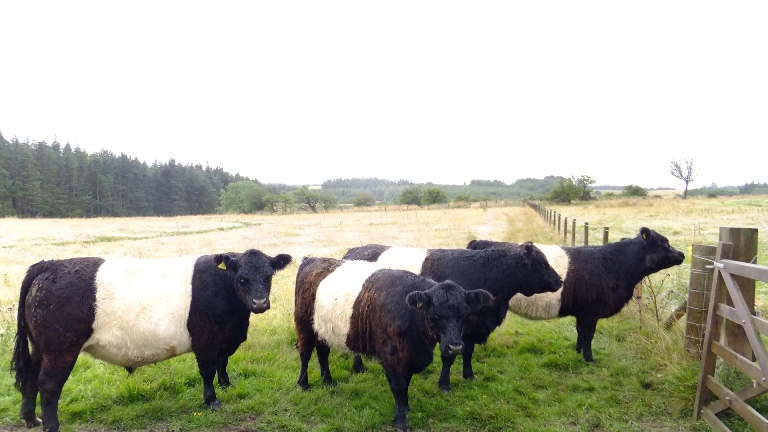
To ensure that the cattle are kept safely on our land Keith advised that a top strand of barbed wire would be useful. Unravelling 600m of barbed wire on a wet moor was not what volunteer Tony had imagined he would be doing when he arrived at the Field Centre this morning but he took up the challenge without complaining!
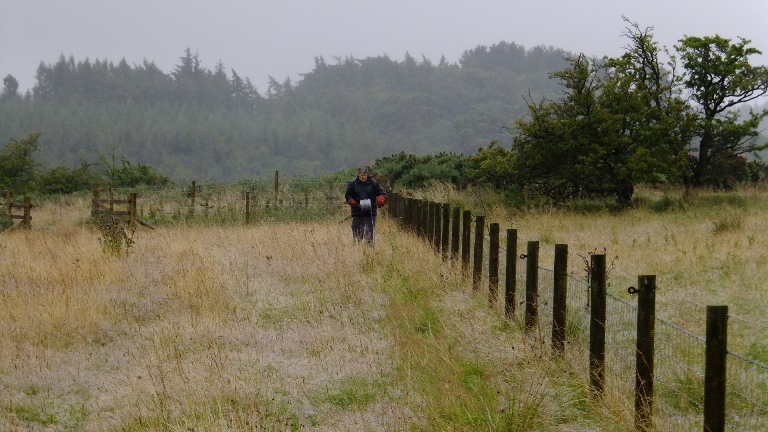
Even when the fence went through thick Gorse!
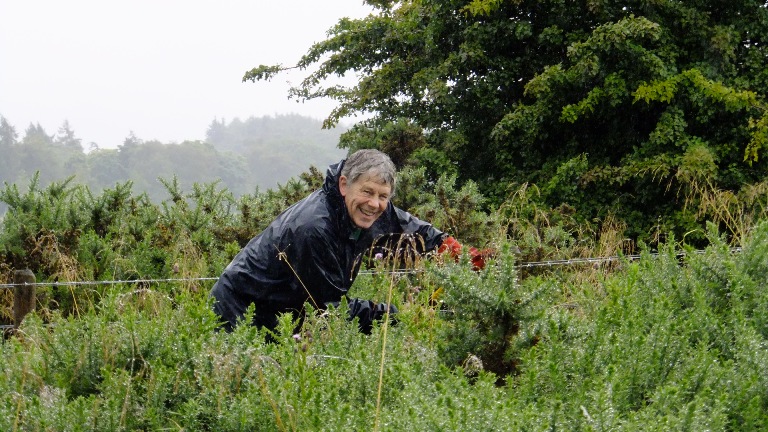
Keith very kindly offered to stay and help and explained the 'ins and outs' of straining wire.
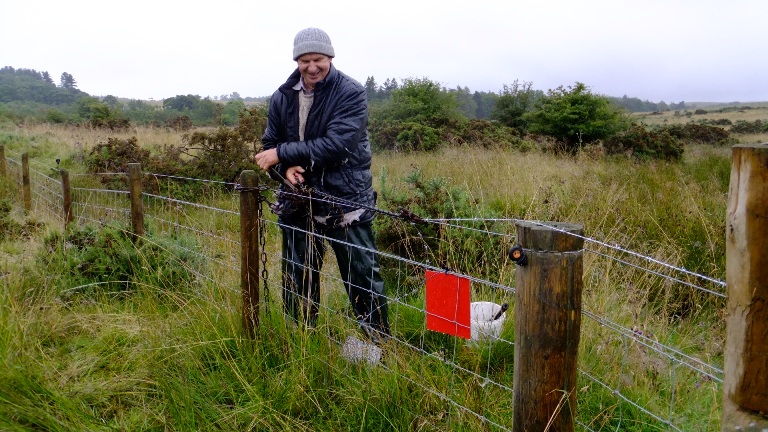
Thanks to Keith and Tony for grafting away in the rain to help benefit the reserve and thank you to Keith for letting us borrow his beautiful cattle. If you visit the reserve over the next few weeks please be sure to close all gates on the moor (including all of the ones on the bridges as the timber isn't strong enough to take our furry friends). If anyone is feeling left out the other half of the fence will be to finish off next week, don't all rush at once!
August Antics
Thursday, August 11th 2011
The children that came to today's 'Wet Wildlife' event really enjoyed their pond-dipping. Afterwards, they made frog masks to take home. There is a whole series of exciting wildlife workshops planned for the rest of this month suitable for families, please see the events section for details.

In the afternoon, a group from Low Mill Outdoor centre enjoyed a walk around the reserve too. Amongst the many flowers out in bloom now are Grass of Parnassus and the beautiful Pepper Saxifrage.

Faces Old and New!
Tuesday, August 9th 2011
Following the open day there has been a lot of interest in volunteering and new people are always welcome to join in on a Tuesday with practical conservation tasks. Some of the members of today's group have been coming to Foxglove for between four and eight years whilst others came for the first time today. Here are some of the group repairing boardwalk on the heathland. Birch pulling, fixing rails and checking mink rafts were some of the other ways in which volunteers helped out across the reserve.

Everyone agreed that it was refreshing to be out on the heathland and not weeding it for a change!

In the afternoon another new person came to visit, Adam Edmonds will be starting work as Deputy Reserve Manager in the next couple of weeks. Adam was in the area and popped in to say hello. Here he is getting to grips with the site map.

Whilst here, Adam was quite happy to answer the site mobile!

Congratulations on your new post Adam and welcome to the team!

Sunshine again at last
Tuesday, August 9th 2011
After weeks of weeding by volunteers, the heathland is looking fantastic as the heather is in full bloom.

Elsewhere, the heavy rain from earlier in the week combined with the warm temperatures, has provided many fungi with perfect conditions. Up in the woodland there are fruiting bodies of all different shapes and sizes.

This one really amused Brian as he went about photographing them!

Meanwhile, Bethany was hard at work carrying out a whole variety of summer maintenance tasks such as brushing the leaves off the bridges and fixing the wire on the boardwalks.

An interesting find
Monday, August 8th 2011
The bird ringers were ringing at a another site on Friday evening when they found this Bedstraw Hawk-moth (Hyles galii) It is an immigrant usually being found on the coast but also occasionally inland.

If many of them arrive together then their caterpillars may be found, which are dark green or brown with bright yellow spots.
Today at Foxglove was CES day 10. As part of the programme Tony used his expertise and familiarity with modern gadget technology to explain to the trainees the benefits and intracacies of tape luring. Some of the younger ringers were completely unfamiliar with the practice and found the detailed explanation extremely beneficial. Even the dog was mesmerised; probably stunned by the level of detail. On the left speaker you can see the on/off switch which is essential and not always readily recognised by those less experienced. It was a useful session very well received. The 'play' switch will be covered next week.

226 birds were caught and processed today, the fourth best day for CES 10 in the 19 years of the Foxglove programme. The incessant rain yesterday and strong winds today had a negative impact on the numbers of birds on the reserve.
How many?
Saturday, August 6th 2011
How many insects can feed from one flower?


The insects were flying, buzzing, hunting and feeding around the flowers in the sunshine. Most were not arguing!
A very wet day
Friday, August 5th 2011
It was very wet today but it did not stop people attending the Coffee Morning at Richmond Town Hall. Volunteers of Foxglove worked hard to ensure the success of the morning. Over £200 was raised. Thank you very much to everyone who helped, however a special thanks must go to Tony and Lilian Cooper who organised the event.
The warm wet weather is continuing to bring out the fungi around the reserve.


A Close Encounter
Thursday, August 4th 2011
Walking along the boardwalk - a movement, then a scuttling sound and WOW!!.....a Common Lizard was running across the planks and then disappeared through the gaps. Of course no camera handy on the right setting. A bit more investigation and damselflies, hoverflies, grasshoppers and Antler Moths were all making the most of the warmth and sunshine.
Climbing back onto the boardwalk there was little hope of the lizard being there again - but yes it was…..sunbathing! Camera out and ready and although he (she?) knew I was there he stayed still to allow me to photograph him, until I got a bit close and then off he scrambled again. You can see that he has been in the wars as he has a very short tail!

Busy volunteers
Wednesday, August 3rd 2011
Foxglove volunteers arrived early today and as ever they were eager to start work. Bird boxes were cleaned out - but more of that later! The wetland was walked and some judicious digging of mud and filling of holes was carried out. A path that had enjoyed the attentions of the rabbits was repaired and more invasive Birch was removed from the area opposite the plantation. The small piece of heath on the north side of the road was attacked and amazingly some beautifully flowering Heather was found under the Gorse, Willow and Birch which was being removed.
But it was not all hard work. As the area was cleared we disturbed an adult frog, an adult and a young toad. Trying to keep track of them so John could photograph them proved interesting.

He finally managed to get this photo of the young toad.

Back to the bird nest boxes. As this box was checked it was found to have a roosting bat in it. A quick photograph and the front was replaced leaving it to sleep the day away. You can see that this bird box is being used regularly by the number of droppings present. Bird boxes are obviously more comfortable than 'proper' bat boxes!

Thank you to all the volunteers who worked hard today at so many different tasks to keep the reserve looking so good.
Busy insects
Tuesday, August 2nd 2011
It was very warm today and the insects were making the most of it. Hover flies were, as their name suggests, hovering around all the flowers, sometimes landing to feed. They are really beautiful.

The bees were busy visiting the thistle flowers. This particular bee is covered with pollen. Lots of thistle seeds to come in the autumn?

Another find today was this damaged wasp's nest. Photographing them this morning did not take long as they were not very happy, but they had settled by this afternoon, allowing this photo to be taken.

CES 9 and Deputy Reserve Manager’s Post
Monday, August 1st 2011
It was a cold beginning to CES 9. As the nets were being put up dawn was breaking.

Several visitors came into the ringing room and the bird ringers demonstrated and explained the bird ringing process. The young visitors, much to their delight, were allowed to release some of the birds.
This Sedge Warbler was caught at 7am.

The day was a record breaker for on visit 9 of our 19th year we caught 346 birds with limited nets out, and less than full strength in the ringing team. This is an amazing number and the highest by a long way for this particular visit. 216 birds were new, of 20 different species. Notable was the Sedge Warbler, 15 Siskin, 34 Greenfinch, 43 Chaffinch, 15 Blackcap and 16 Willow Warbler.
On a slightly different tack, the Management Group has now sifted the 70 applications for the Deputy Reserve Manager's post and 9 people have been called forward for interview on Thu 4 Aug. The field was very strong with quality that made the choice extremely difficult. The new Deputy Reserve Manager, to be selected from 5 men and 4 women, will hopefully be appointed on Fri 5 Aug.


.JPG)
